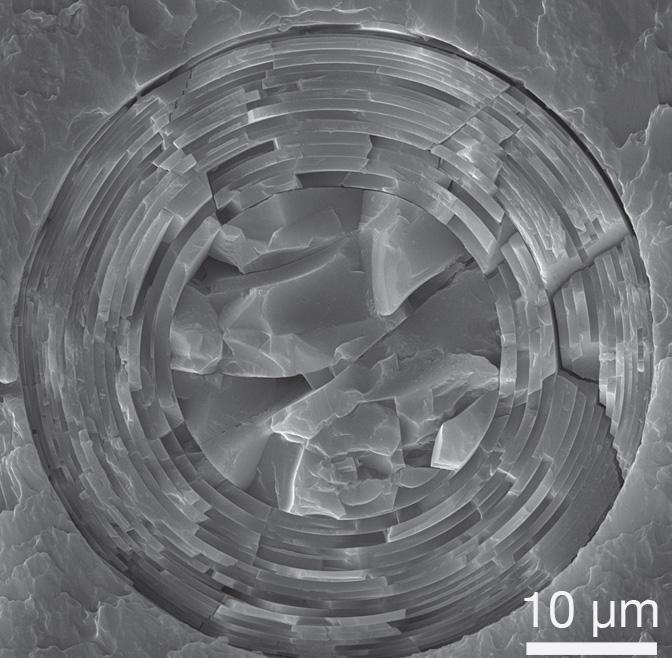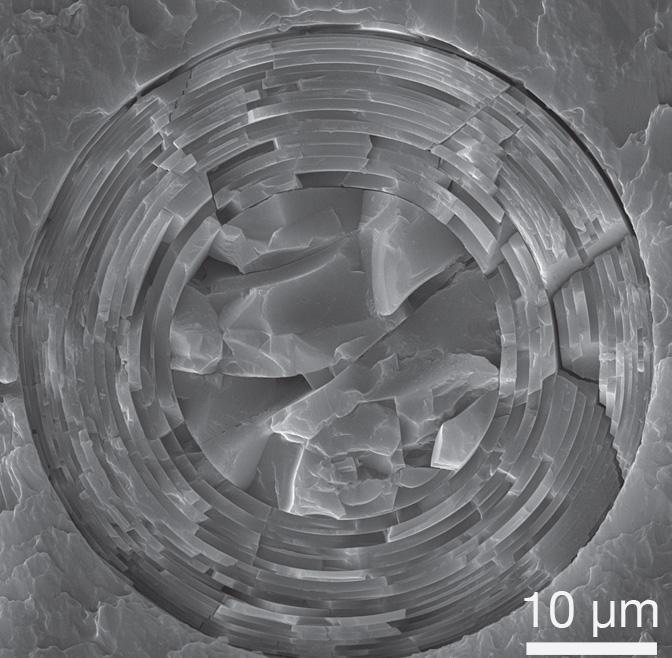
Credit: Kesari Lab/Brown Universtiy
PROVIDENCE, R.I. [Brown University] — Sea sponges known as Venus' flower baskets remain fixed to the sea floor with nothing more than an array of thin, hair-like anchors made essentially of glass. It's an important job, and new research suggests that it's the internal architecture of those anchors, known as basalia spicules, that helps them to do it.
The spicules, each about half the diameter of a human hair, are made of a central silica (glass) core clad within 25 thin silica cylinders. Viewed in cross-section, the arrangement looks like the rings in a tree trunk. The new study by researchers in Brown University's School of Engineering shows that compared to spicules taken from a different sponge species that lacks the tree-ring architecture, the basalia spicules are able to bend up to 2.4 times further before breaking.
"We compared two natural materials with very similar chemical compositions, one of which has this intricate architecture while the other doesn't," said Michael Monn a Brown University graduate student and first author of the research. "While the mechanical properties of the spicules have been measured in the past, this is the first study that isolates the effect of the architecture on the spicules' properties and quantifies how the architecture enhances the spicules' ability to bend more before breaking."
That bendability likely enables the spicules to weave themselves into the silt of the seafloor, helping to assure the sponge's secure attachment. A better understanding of how this internal spicule architecture works might be useful in developing new human-made materials, the researchers say.
The research is published in the Journal of the Mechanical Behavior of Biomedical Materials.
When study co-author Haneesh Kesari, assistant professor in Brown's School of Engineering, first saw the internal architecture of the basalia spicules, he was immediately intrigued by the consistency and regularity of the pattern. "It looked like a figure from a math book," he said.
Since then, Kesari has been working to understand the architecture's significance. In 2015, Kesari, Monn and several colleagues published an analysis showing that the arrangement of the spicules' concentric layers — which gradually decrease in thickness from the center toward the outside — is mathematically optimal for maximizing the spicules' strength.
This latest study is a more direct test of a property the researchers believe is important for the spicule anchors: bending failure strain, which is the extent to which something can bend without breaking.
"Intuitively, it makes sense that the spicules would be better anchors if they could twist their way through the silt", Monn said. "It would make them much harder to pull out than if they were pin straight. The mechanical property that is most associated with that desirable functionality would be bending failure strain."
For the study, the researchers used an apparatus they designed specifically to test how far spicules can bend. The spicules are laid across a stage with a gap in the middle. A small wedge is then lowered onto the spicule, which bends it down into the gap. A camera on the side of the device takes pictures, providing for precise measurements of how far the spicules bend before they break.
Monn and Kesari used the device to test both the basalia spicules from Venus' flower baskets as well as spicules from a different species — the orange puffball sponge. The two sets of spicules have roughly the same diameters and an essentially identical silica composition. But the puffball spicules lack the internal architecture of the flower baskets. So any difference in bending strain between the two could be attributed to the architecture.
The experiments showed that the flower basket spicules could bend 140 percent more than the puffball spicules.
"The extent to which the spicules could bend was quite surprising since they are essentially made of glass", Monn said. Engineers often use a model called Euler-Bernoulli beam theory to calculate how much a beam will bend under a load but that only applies when the magnitude of the bending is very small. The spicules proved able to bend too much for the theory to accommodate.
"What that says is that the classical theories that we use to analyze mechanical tests of engineering materials may not be accurate when dealing with biological materials," Monn said. "So we need to also change our analysis approach and not just copy and paste what we've been using for engineering materials."
Monn hopes that studies like this one will provide the data needed to devise proper models to explain the properties of these natural structures, and eventually make use of those structures for new human-made materials.
###
The research was supported by the National Science Foundation (1562656) and the American Society of Mechanical Engineers.
Media Contact
Kevin Stacey
[email protected]
401-863-3766
@brownuniversity
http://news.brown.edu/
Original Source
https://news.brown.edu/articles/2017/06/spicule
############
Story Source: Materials provided by Scienmag





